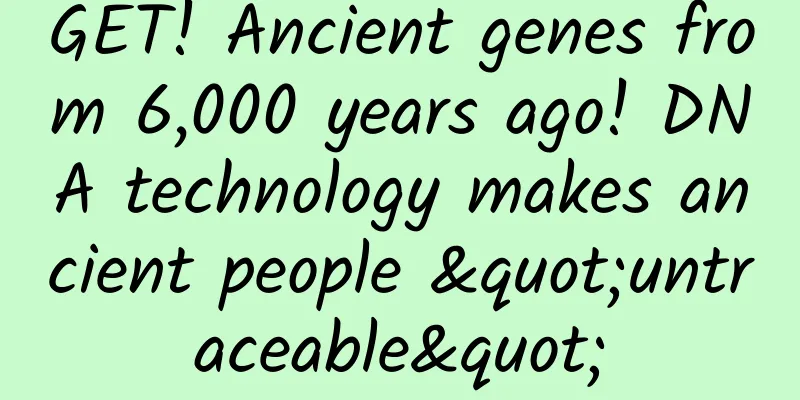GET! Ancient genes from 6,000 years ago! DNA technology makes ancient people "untraceable"

|
On September 17, the Wuxi Institute of Cultural Relics and Archaeology and Fudan University jointly released a latest scientific and technological archaeological achievement - a human bone detection report from the Majiabang culture period at the Ma'an Site in Wuxi City - which successfully obtained for the first time the ancient human genome data from the Majiabang culture period 6,000 years ago. Ma'an Ancients: "Wuxi People" 6,000 Years Ago The Ma'an site is located in Hudai Town, Binhu District, Wuxi City, with an excavation area of about 3,100 square meters. The Ma'an site has a long time span. The bottom layer of relics is more than 6,000 years old and belongs to the Majiabang culture. On top of it are relics from the Songze culture period and relics and cultural relics from the Shang and Zhou dynasties, Tang and Song dynasties. During the Natural and Cultural Heritage Day event in June 2023, Wuxi live broadcast the archaeological excavation of two tombs of the Majiabang culture at the Ma'an site in Wuxi, where two ancient human skeletons were discovered. The School of Archaeology of Fudan University extracted two skeleton samples, and successfully extracted ancient DNA from one of the skeletons. The sample is male, and its maternal genetic type belongs to haplogroup F1a1'4. Retrieving and comparing the published mitochondrial DNA data extracted from archaeological excavations in various ancient regions, this type of DNA is found in ancient sites in northern Vietnam (4000-2000 years ago), northern Laos (3000 years ago), Indonesia (2000 years ago), the Philippines (1800 years ago), Guangxi (1500 years ago) and hanging coffin burials in northern Thailand (2500-800 years ago). Cracking the "code" of kinship relations among the ancient people of Ma'an Comparing the genetic type of the ancient people of Majiabang culture in Wuxi Ma'an site with the genetic pedigrees of modern people of various language families, the study found that the ancient people of Ma'an had a maternal genetic connection with ancient peoples in southern China and Southeast Asia . At the same time, compared with the pedigrees of modern people of various language families, it was also found that the ancient people of Ma'an had a close genetic connection with modern Dong-Tai people and the Han nationality in southern China. Majiabang culture is the earliest Neolithic culture discovered in Wuxi, and can be said to be the source of Wuxi regional civilization. This study obtained the mitochondrial genome sequence of ancient samples in the lower reaches of the Yangtze River for the first time , filling the gap in ancient DNA research in southern China caused by environmental impact and poor preservation, and providing an important reference for understanding the origin and migration of prehistoric archaeological cultural populations in the lower reaches of the Yangtze River. What is the difference between ancient DNA archaeology and traditional archaeology? How to conduct ancient DNA archaeology? Compared with traditional archaeology, ancient DNA is a relatively new direction. It is a new method that uses modern molecular biology, bioinformatics and other technologies to extract and analyze ancient DNA molecules , and then combines multidisciplinary evidence such as archaeology, physical anthropology, linguistics, etc. to study a series of archaeological issues such as human origins, population migration and mixing, ancient microbial evolution mechanisms, and the social organization and structure of ancient society . The most important step in the study of ancient DNA is the extraction of ancient DNA molecules . The entire process includes the collection of human bone samples, material pretreatment, sample grinding into powder, extraction of ancient DNA molecules from bone powder, construction of a DNA library for next-generation sequencing, high-throughput sequencing, and subsequent large-scale population genetics analysis . DNA technology: making ancient people "untraceable" Ancient DNA technology is often used for individual and group analysis of ancient people. With ancient DNA technology, information about the gender, intermarriage, death, etc. of ancient people that has been buried for thousands or even tens of thousands of years may be re-deciphered. For example, the Ancient DNA Laboratory of Jilin University is currently extracting and analyzing ancient DNA from Cao Cao's tomb. The remains of the female owner unearthed from the Laoshan Han Tomb in Beijing 20 years ago were not well preserved, so some people thought she was a woman from the Western Regions with a high nose and deep eyes. However, after DNA analysis, it was found that the DNA sequence of the female owner of the Laoshan Han Tomb in Beijing represented the genetic traits of a certain ancestral type of modern people in East Asia, which means that she was a Han woman, not a woman from the Western Regions. Ancient DNA technology has also been used to conduct some research in population genetics . For example, the Yelu clan, a royal family of the Liao Dynasty, and the Xiao clan, a descendant clan that everyone knows, we found through separate studies that although they have been intermarrying for generations, they are completely different in genetics and are quite far apart, which is a complete exogamy. Ancient DNA analysis. Photo courtesy: Wang Minghui Ancient DNA can also help us understand some special death cases . For example, we found nearly 100 human bones in a house that collapsed after a fire at the Haminmangha site in Tongliao, Inner Mongolia. They had no obvious signs of death, which is very rare in other archaeological sites. With the help of DNA analysis, we extracted ancient DNA residues of plague bacteria from the bones. Combined with paleoenvironmental research, we believe that these people may have died from a sudden outbreak of plague. At that time, in order to isolate the infection, the dead were concentrated in one house and the house was burned down. Ancient DNA technology can not only study ancient people, but also ancient animals . For example, the origin of Chinese horses, the distribution of horse coat colors... It is difficult to imagine doing this research in traditional archaeology. Ancient DNA analysis has expanded the scope of what we could not do before. Schematic diagram of the coat color distribution of domestic horses in ancient China. Photo courtesy: Wang Minghui Comprehensive sources: Guangming Online, Science and Technology Daily, China News Service, etc. |
<<: I, an owl, a bird of prey!
>>: Drinking moderately can soften blood vessels? Rumor! These 5 points are really helpful...
Recommend
Can you fight chronic inflammation by eating? The anti-inflammatory fighter on the dining table
Audit expert: Peng Guoqiu Deputy Chief Physician,...
Hot search! I get stomachache when I get angry, what's going on?
Expert of this article: Wang Xiaohuan, Doctor of ...
How to open a WeChat mini program store? How to open your own store in WeChat Mini Program?
How to open a WeChat mini program store? How to o...
Xiaohongshu’s hot-selling notes trends!
There were Labor Day and other promotional events...
After analyzing 670 million mobile app push notifications, we saw several interesting trends:
Push notifications are the cornerstone of every m...
Share a slimming meal project suitable for women (with methods of attracting traffic and monetization)
During the holidays, I have been doing nothing bu...
Are "999", "990" and "925" the same? What kind of silver are they?
Review expert: Gan Qiang, lecturer at Beijing Ins...
Case analysis: How to use selling point marketing for products?
The farthest distance in the world is not the dis...
China Industrial Technology Software Industry Alliance: 2020 Industrial Internet APP Development White Paper
A preliminary analysis was conducted on the overa...
Weekly crooked review: The Internet is booming, but it seems to have nothing to do with us
This week's Internet industry was full of ups...
Musk participates in "saving the earth"! NASA launches the first planetary defense test mission
66 million years ago, an asteroid about 10 kilome...
Tips for creating short video scripts
A script is the outline needed for shooting a sho...
Aesthetic Corrective Makeup Ultimate Lifting Base Makeup Treatment
Introduction to the resources for the ultimate li...
The logic behind the issuance of the radio and television regulatory order: to prevent television from being “screenized”
As early as 2011, the State Administration of Rad...
Pinduoduo Promotion: Tips for Obtaining Free Traffic!
Just one trick allows you to quickly get free tra...









